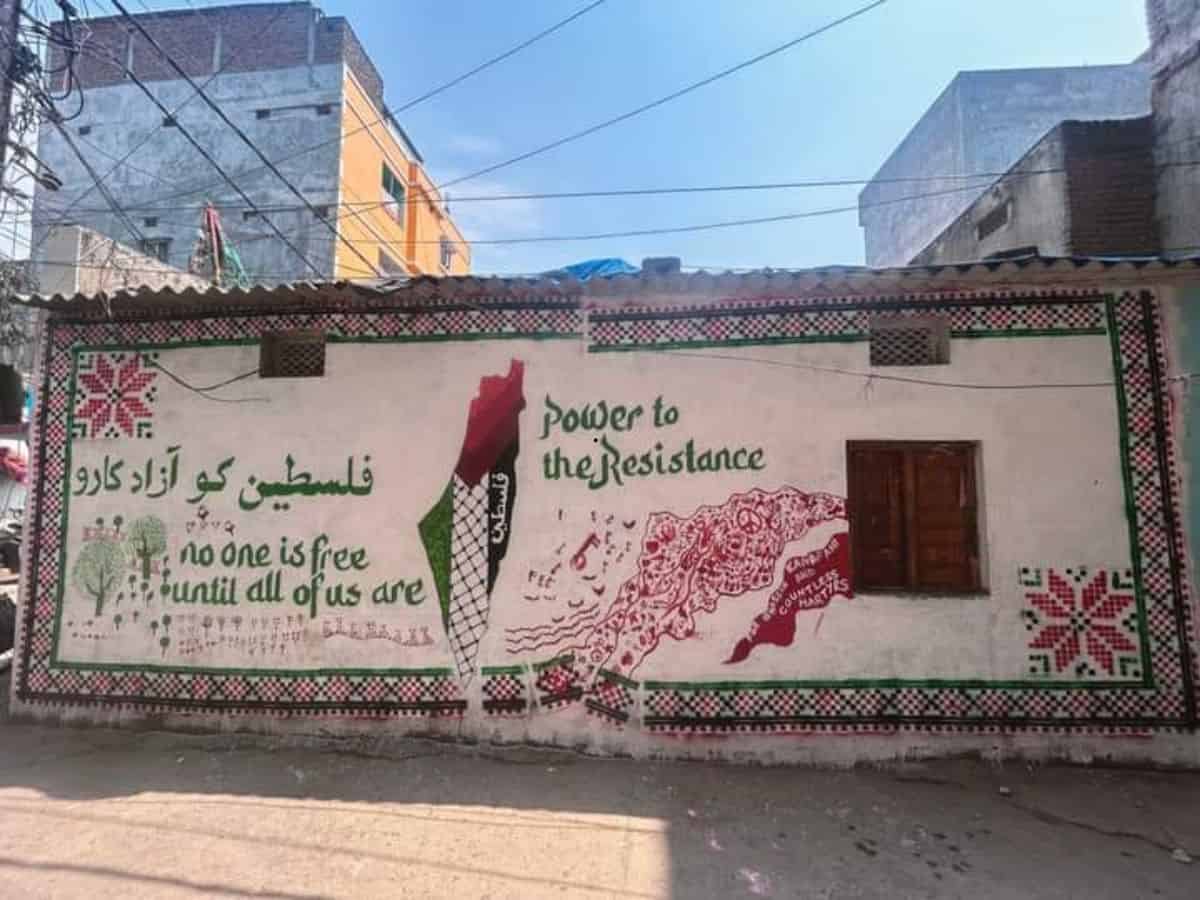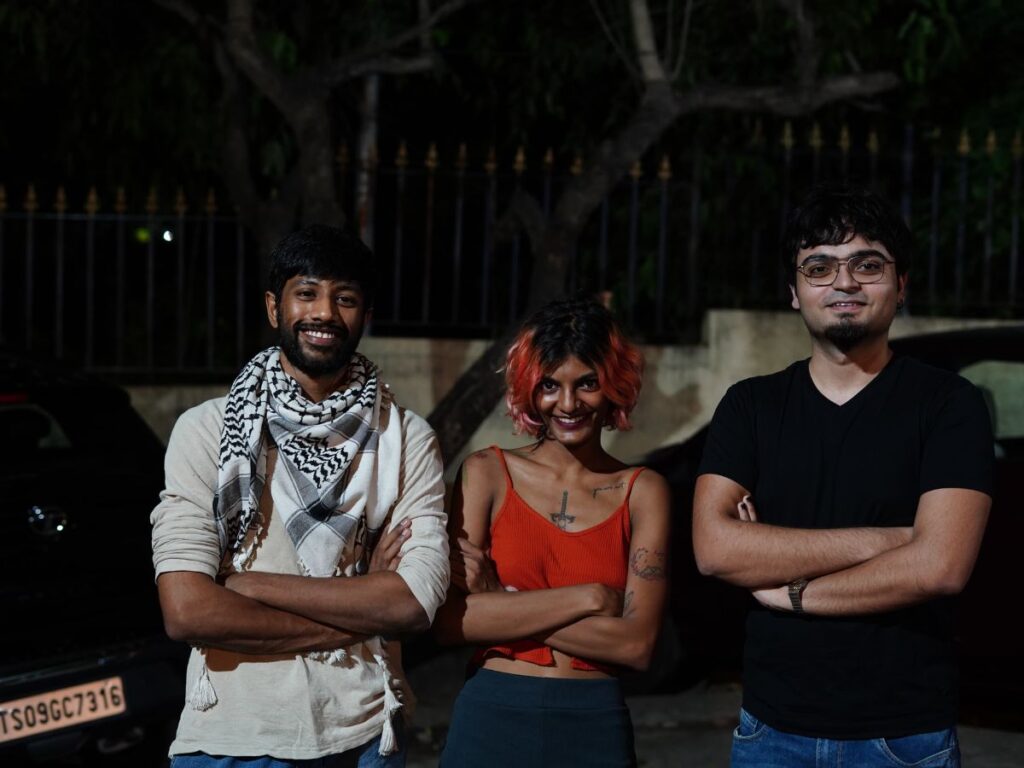
By Hathim Ashir
Hyderabad: In the city’s MS Maqta locality, a crowded narrow lane close to Hussain Sagar lake leads to walls which are adorned with exquisite murals.
An unusual entrance to the locality goes across railway tracks. As you proceed, you will be filled with awe and joy as you walk by the walls and take in the murals that are painted over three or four stories of buildings. Seeing all of the murals will consume at least an hour. Artists and art enthusiasts worldwide are familiar with this area, which is referred to as ‘Art District’.
Recently, a group of young artists painted a mural in response to the renewed global focus on the Palestine conflict. The artwork was created by a group that calls itself ‘Art against Oppression’ (AAO); it uses art as a form of support and solidarity with Palestine and its people and against the ‘oppressive social order’. “We use art initiate discussions on Palestine and the current situation there,” said one of the members of the art group.

Hyderabad-based members of AAO Sagnik, Likhita, Kalyan, Ayushi, Shravni, and Srestha are in-charge of painting the mural. Sagnik, an artist, and his companions initially founded AAO in Kolkata, with more than fifty members.
After moving to Hyderabad, Sagnik is trying to build a similar art forum here as well. “I found people willing to participate in the same cause,” he said. “Back then, in Kolkata, my friends and I got together and thought of making a group to use art against all forms of oppression,” says Sagnik.
Likhita states, “We are interested in the cause and have a strong enthusiasm for politics in general. We therefore believe that opposing all forms of oppression and dictatorship is a good notion. That’s how we first connected.”
“We were slow as it took us a while to decide what to do, where to do it, how it can be accomplished, and how many people were to be involved. Then we decided to creating a mural. We had anywhere between ten and twelve artists working on the mural at a time,” she says.

Bridging the gap with art
“There’s this gap between the political and artistic spheres; artists tend to be very self-oriented and detached from external events. We wish to change this by adopting a collective perspective on art, moving away from the individual and toward something more usable, where everyone can collaborate and exchange ideas,” Sagnik says.
They group is growing and has already started receiving responses not only artists, but people from diverse backgrounds.
Another member of the group, Kalyan, who works with social development organisations, says, “Art is a way for us to talk about history. There are still those who think that October 7 marks the beginning of the Gaza war. Art may be utilised to educate people about the past.”
And artworks like these,” he said pointing at the Palestine mural, “help us understand the causes of the Palestinian dilemma.”
The mural features numerous symbols of the Palestinian struggle, including the olive, watermelon, keys, and keffiyeh, and it states “Free Palestine” in Urdu with the words “No one is free until all of us are.”
Even though Maqta is renowned for its wall paintings and has a plethora of artistic expression, AAO was motivated to paint in Maqta for another important reason. It’s one of the neighborhoods where members of the working class proletariat predominate.
Against ‘oppressive social order’
“We are trying to organise people, and stage stand in solidarity against the oppressed. We want to mobilize communities,” says Kalyan.
Likhita said, “Power to the resistance is one of our key messages. Usually, there is a disagreement on the definition of the word resistance. Hamas is one of the resistance groups in Palestine, and there is significant disagreement about their actions on October 7. We are declaring our support for the resistance.”
She added, “Students around the world have been protesting for Palestinian rights, blocking university premises, and calling on governments to stop supplying weapons to Israel.”

Sagnik says, “Protests disrupt the normalcy. These student protests demonstrate it. Similarly, art demolishes negative narratives,” he continued.
“We aim to build a forum that welcomes these collective voices and art forms which speak up against the existing oppressive social order,” states the AAO’s manifesto.
Welcoming locality
In addition to Art Against Oppression, these young people have also been promoting the Boycott Divest Sanction (BDS) campaign by handing out flyers throughout Hyderabad and posting notices inside and outside of BDS-affiliated cafes and shops. They have also formed other collectives, such as ‘Palestine on Roads’ and ‘United for Peace’.
Muhammad Hassan, a relative of the person on whose wall the mural was painted in MS Maqta, said, “We support Palestine, which is why we permit the painting here.” Every time we walk by the painting, we are reminded of and are filled with the feeling of Palestine. We are acting on behalf of humanity.”
Maqta residents gave us a very good response, say the artists. “The locals provided us with cold water and refreshments under the heat, and the kids joined us while we painted the mural.”

According to Sagnik, the nicest experience he ever had was painting the mural and seeing
the reaction from the community.
Art Against Oppression looks forward to painting more murals in support of Palestine across the city. “But it is not easy to get permission everywhere.”

